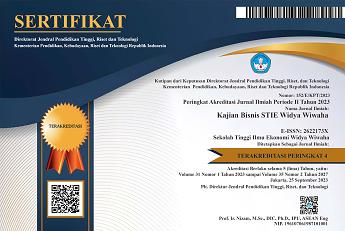ANALISIS NIAT BELI KONSUMEN MELALUI ONLINE FOOD DELIVERY DI ERA PANDEMIC COVID-19
DOI:
https://doi.org/10.32477/jkb.v29i2.242Keywords:
Intention, usefulness, ease of use, online service, convenience motivationAbstract
Online food delivery (OFD) is an innovative and simple way of purchasing food online. This study aims to examine consumer purchase intentions to use OFD Go-food services during the Covid-19 Pandemic. This study uses a survey of 100 consumers who have the Go-jek application in Kebumen to fill out the questionnaire. The sample technique was taken by using purposive sampling technique, then the data were processed using SPSS version 25.0 and analyzed using path analysis. The findings of this study indicate that the convenience motivation and perceived ease of use are proven unable to directly influence consumer intention to use OFD. Meanwhile, convenience motivation and perceived ease of used have an effect on perceived usefulness. Other results indicate that perceived usefulness is able to act as a mediating variable between convenience motivation, perceived ease of use on consumer purchase intentions using OFD
Downloads
References
Abdullah, F., Ward, R., & Ahmed, E. (2016). Investigating the influence of the most commonly used external variables of TAM on students’ perceived ease of use (PEOU) and perceived usefulness (PU) of e-portfolios. Computers in Human Behavior, 63, 75–90. https://doi.org/10.1016/j.chb.2016.05.014
Ajzen, I. (2015). Consumer attitudes and behavior: the theory of planned behavior applied to food consumption decisions. Rivista di economia agraria, 70(2), 121–138. https://doi.org/10.13128/REA-18003
Annaraud, K., & Berezina, K. (2020). Predicting satisfaction and intentions to use online food delivery: What really makes a difference? Journal of Foodservice Business Research, 23(4), 305–323. https://doi.org/10.1080/15378020.2020.1768039
Berry, L. L., Seiders, K., & Grewal, D. (2002). Understanding service convenience. Journal of Marketing, 66(3), 1–17. http://www.dhruvgrewal.com/wp-content/uploads/2014/09/2002-JM-SERVICE-CONVENIENCE-MODEL.pdf
Chawla, D., & Joshi, H. (2019). Consumer attitude and intention to adopt mobile wallet in india - an empirical study. International Journal of Bank Marketing, 37(7), 1590–1618. https://doi.org/10.1108/IJBM-09-2018-0256
Chiu, C., Wang, E. T. G., Fang, Y., & Huang, H. (2014). Understanding customers’ repeat purchase intentions in B2C e-commerce: the roles of utilitarian value, hedonic value and perceived risk. Information System Journal, 24(1), 85–114. https://doi.org/10.1111/j.1365-2575.2012.00407.x
Cho, M., Bonn, M. A., & Li, J. J. (2019). Differences in perceptions about food delivery apps between single-person and multi-person households. International Journal of Hospitality Management, 77(Vol. 77, pp. 108–116), 0–1. https://doi.org/10.1016/j.ijhm.2018.06.019
Choon Ling, K., Bin Daud, D., Hoi Piew, T., Keoy, K. H., & Hassan, P. (2011). Perceived risk, perceived technology, online trust for the online purchase intention in Malaysia. International Journal of Business and Management, 6(6). https://doi.org/10.5539/ijbm.v6n6p167
Colwell, S. R., Aung, M., Kanetkar, V., & Holden, A. L. (2008). Toward a measure of service convenience: Multiple-item scale development and empirical test. Journal of Services Marketing, 22(2), 160–169. https://doi.org/10.1108/08876040810862895
Davis, F. D. (1989). Perceived usefulness, perceived ease of use, and user acceptance of information technology. MIS Quartely, 13(3), 319–340. https://doi.org/10.2307/249008
Featherman, M. S., & Pavlou, P. A. (2003). Predicting e-services adoption : a perceived risk facets perspective. International Journal of Human-Computer Studies, 59(4), 451–474. https://doi.org/10.1016/S1071-5819(03)00111-3
Izquierdo-yusta, A., & Schultz, R. J. (2011). Understanding the effect of internet convenience on intention to purchase via the internet. Journal of Marketing Development and Competitiveness, 5(4), 32–50.
Jeng, S. P. (2016). The influences of airline brand credibility on consumer purchase intentions. Journal of Air Transport Management, 55, 1–8. https://doi.org/10.1016/j.jairtraman.2016.04.005
Jiang, L. (Alice), Yang, Z., & Jun, M. (2013). Measuring consumer perceptions of online shopping convenience. Journal of Service Management, 24(2), 191–214. https://doi.org/10.1108/09564231311323962
Jih, W. J. (2007). Effects of consumer-perceived convenience on shopping intention in mobile commerce: an empirical study. International Journal of E-Business Research (IJEBR), 3(4), 33–48. https://doi.org/10.4018/jebr.2007100102
Keeble, M., Adams, J., Sacks, G., Vanderlee, L., White, C. M., Hammond, D., & Burgoine, T. (2020). Use of online food delivery services to order food prepared away-from-home and associated sociodemographic characteristics: A cross-sectional, multi-country analysis. International Journal of Environmental Research and Public Health, 17(14), 1–17. https://doi.org/10.3390/ijerph17145190
Koufaris, M., & Hampton-sosa, W. (2004). The development of initial trust in an online company by new customers. Information & Management, 41(3), 377–397. https://doi.org/10.1016/j.im.2003.08.004
Lee, E. Y., Lee, S. B., & Jeon, Y. J. J. (2017). Factors influencing the behavioral intention to use food delivery apps. Social Behavior and Personality, 45(9), 1461–1474. https://doi.org/10.2224/sbp.6185
Mohammadi, H. (2015). A study of mobile banking loyalty in Iran. Computers in Human Behavior, 44, 35–47. https://doi.org/10.1016/j.chb.2014.11.015
Moslehpour, M., Pham, V. K., Wong, W. K., & Bilgiçli, I. (2018). E-purchase intention of Taiwanese consumers: Sustainable mediation of perceived usefulness and perceived ease of use. Sustainability (Switzerland), 10(1). https://doi.org/10.3390/su10010234
Mujahidin, A. (2020). Pengaruh fintech e-wallet terhadap perilaku konsumtif pada generasi millennial. Inovbiz: Jurnal Inovasi Bisnis, 8(2), 143. https://doi.org/10.35314/inovbiz.v8i2.1513
Oliveira, T., Thomas, M., Baptista, G., & Campos, F. (2016). Mobile payment: Understanding the determinants of customer adoption and intention to recommend the technology. Computers in Human Behavior, 61(2016), 404–414. https://doi.org/10.1016/j.chb.2016.03.030
Prabowo, G. T., & Nugroho, A. (2019). Factors that Influence the Attitude and Behavioral Intention of Indonesian Users toward Online Food Delivery Service by the Go-Food Application. Advances in Economics, Business and Management Research, 72(12th Icbmr 2018), 204–210. https://doi.org/10.2991/icbmr-18.2019.34
Purvis, B., Mao, Y., & Robinson, D. (2019). Three pillars of sustainability : in search of conceptual origins. Sustainability Science, 14(3), 681–695. https://doi.org/10.1007/s11625-018-0627-5
Riptiono, S. (2020). Pengaruh Allocentris dan Animosity terhadap Niat Beli Konsumen pada Produk Makanan Lokal dengan Ethnocentrism sebagai Intervening Variabel. Jurnal Aplikasi Manajemen Dan Bisnis, 6(2), 379–388. https://doi.org/http://dx.doi.org/10.17358/jabm.6.2.379
Shin, D. H. (2009). Towards an understanding of the consumer acceptance of mobile wallet. Computers in Human Behavior, 25(6), 1343–1354. https://doi.org/10.1016/j.chb.2009.06.001
Singh, S., & Srivastava, R. . (2018). Predicting the Intention to Use Mobile Banking in India Introduction. International Journal of Bank Marketing, 36(2), 357–378.
Statista. (2019). Online food delivery report 2019. Available Online: Https://Www.Statista.Com/Study/40457/Food- Delivery.
Troise, C., O’Driscoll, A., Tani, M., & Prisco, A. (2020). Online food delivery services and behavioural intention – a test of an integrated TAM and TPB framework. British Food Journal. https://doi.org/10.1108/BFJ-05-2020-0418
Yeo, V. C. S., Goh, S. K., & Rezaei, S. (2017). Consumer experiences, attitude and behavioral intention toward online food delivery (OFD) services. Journal of Retailing and Consumer Services, 35(December 2016), 150–162. https://doi.org/10.1016/j.jretconser.2016.12.013









